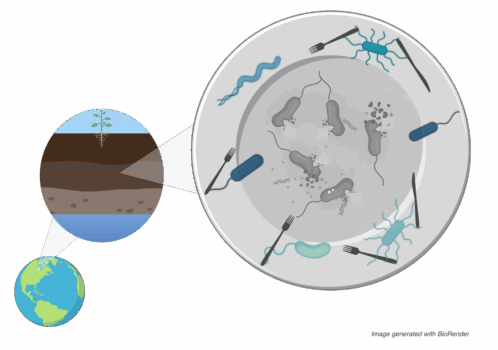
The Science
Microbes, which include organisms like bacteria, are tiny living things that inhabit virtually every environment on Earth. Soil microbes play a crucial role in breaking down organic matter and are crucial drivers of global nutrient cycles that support all terrestrial ecosystems. ENIGMA scientists studied what happens when these microorganisms die and leave behind remains known as necromass. After dead microbes were added to a sample of soil, living microorganisms were observed to grow and change, suggesting that they were using the remains of the dead microbes as a source of food and/or energy. All necromass strains induced community-level growth responses. This finding sheds light on nutrient cycling in the soil microenvironment and how microorganisms interact with their surroundings.
The Impact
The most valuable insight from this research is the understanding of how microbial remains can stimulate the growth of certain microorganisms and influence the composition of microbial communities underground. The study using metabolomics, revealed nucleic acid constituents and amino acids are the primary nutrients in necromass, available for microbial utilization. The researchers also identified microbes efficient at processing essential nutrients—like nitrogen and phosphorus—more quickly.
The work advances our understanding of microbial carbon sources and community dynamics, crucial for predicting how soil ecosystems will respond to environmental stressors. Providing new insights into the dynamics of microbial communities and their responses to changes in their surroundings, with the potential to contribute to the development of more efficient and sustainable technologies for predicting models of how microbes respond to change.
The Summary
Researchers collected soil samples from the field site and brought them to the laboratory for analysis. They then added remains of dead microorganisms to the sediment samples and observed how the microorganisms in the soil responded. They analyzed genetic material from the soil to pinpoint which types of microorganisms were present, and how they were interacting with the available nutrients. They also used a tool called a mass spectrometer to identify the different types of molecules present in the soil before and after adding the nutrients. Together, these data offered a more complete picture of several factors that affect the growth and activity of soil microorganisms. This research advances ENIGMA’s mission to understand ecosystem-scale processes by revealing how microbial death and recycling influence community composition and function in subsurface environments.
Publication
Finley, BK; Enalls, BC; de Raad, M; Al Said, M; Chen, M; Joyner, DC; Hazen, TC; Northen, TR; Chakraborty, R. Unraveling the influence of microbial necromass on subsurface microbiomes: metabolite utilization and community dynamics. ISME Communications (2025), DOI:10.1093/ismeco/ycaf006, OSTI: 2526567
Contact

Science Lead, Environmental Atlas
Lawrence Berkeley National Laboratory
rchakraborty@lbl.gov
Bri Finley,
Postdoctoral Fellow, Climate & Ecosystems
Lawrence Berkeley National Lab

